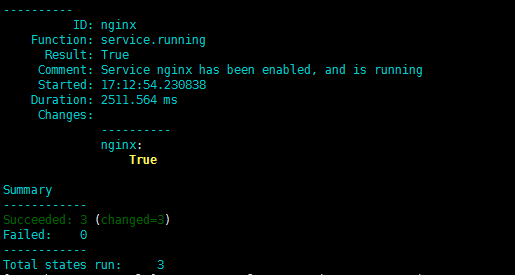SLS文件定义
SLS(代表SaLt State文件)是Salt State系统的核心。SLS描述了系统的目标状态,由格式简单的数据构成。这经常被称作配置管理
top.sls 是配置管理的入口文件,一切都是从这里开始,在master 主机上,默认存放在/srv/salt/目录.
top.sls 默认从 base 标签开始解析执行,下一级是操作的目标(被控主机),可以通过正则,grain模块,或分组名,来进行匹配,再下一级是要执行的state文件,不包换扩展名。
创建top.sls
(一)被控主机的匹配
#通过正则进行匹配的示例, base: '*': - users #为users.sls或users目录 #通过分组名进行匹配的示例,必须要有 - match: nodegroup base: master1: - match: nodegroup - users #通过grain模块匹配的示例,必须要有- match: grain base: 'os:CentOS': - match: grain - users
(二)编写state文件
首先说一下sls的命名空间
A)、SLS文件的扩展名 .sls 被省略。 (例如. webserver.sls 变成 webserver) B)、子目录可以更好的组织,每个子目录都由一个点来表示.(例如 webserver/dev.sls 可以简称为 webserver.dev) C)、如果子目录创建一个init.sls的文件,引用的时候仅指定该目录即可. (例如 webserver/init.sls 可以简称为 webserver) D)、如果一个目录下同时存在webserver.sls 和 webserver/init.sls,那么 webserver/init.sls 将被忽略,SLS文件引用的webserver将只引用webserver.sls
示例:
1)初始化配置
[root@k8s_master salt]# cat /etc/salt/master | grep -v '^#|^$' cachedir: /var/cache/salt/master auto_accept: True file_recv: True file_roots: base: - /srv/salt/ pillar_roots: base: - /srv/pillar pillar_opts: True nodegroups: master1: 'L@k8s_master' agents: 'L@k8s_node1,k8s_node2'
2)配置grains_module
创建目录并编写脚本
[root@k8s_master salt]#install -d /srv/salt/_grains [root@k8s_master salt]# cat /srv/salt/_grains/test_grains.py #!/usr/bin/env python #-*-coding:utf-8-*- import os,sys,commands def get_custom_grains(): grains = {} _open_file=65535 try: getulimit = commands.getstatusoutput('source /etc/profile;ulimit -n') except Exception,e: print e print getulimit,type(getulimit) if getulimit[0] == 0: _open_file=int(getulimit[1]) grains['max_open_files'] = _open_file return grains
刷新并重载模块
#同步grains模块,运行 [root@k8s_master pillar]#salt '*' saltutil.sync_all #刷新模块(让minion编译模块) [root@k8s_master pillar]#salt '*' sys.reload_modules
验证
[root@k8s_master pillar]# salt '*' grains.item max_open_files k8s_node1: ---------- max_open_files: 1024 k8s_node2: ---------- max_open_files: 1024 k8s_master: ---------- max_open_files: 1024
3)配置pillar
[root@k8s_master pillar]# cat top.sls base: 'master1': - match: nodegroup - master1 'agents': - match: nodegroup - agents [root@k8s_master pillar]# cat master1.sls nginx: root: /www [root@k8s_master pillar]# cat agents.sls nginx: root: /data
验证
[root@k8s_master pillar]# salt '*' pillar.data nginx k8s_master: ---------- nginx: ---------- root: /www k8s_node2: ---------- nginx: ---------- root: /data k8s_node1: ---------- nginx: ---------- root: /data
4)配置state
[root@k8s_master salt]# cat top.sls base: '*': - nginx [root@k8s_master salt]# cat nginx.sls nginx: #state名称 pkg: #管理对象类型:pkg(进行软件安装 yum/apt) - installed #pkg要执行的方法: install,如果未安装就进行安装 file.managed: - source: salt://nginx/nginx.conf #配置模板文件位置 - name: /etc/nginx/nginx.conf - user: root - group: root - mode: 644 - template: jinja
- backup:minion #备份 - require: - pkg: nginx service.running: - enable: True #检查服务是否在开机启动服务队列中 - reload: True #表示服务支持reload操作,不加则默认执行restart操作 - watch: #检测nginx.conf是否发生变化,如果发生变化会执行reload操作,pkg为确保nginx安装成功 - file: /etc/nginx/nginx.conf - pkg: nginx
nginx.conf配置文件
[root@k8s_master salt]# cat nginx/nginx.conf
user nginx;
worker_processes {{ grains['num_cpus'] }}; #采用grains获取本地的值,与设备cpu核数一致
{% if grains['num_cpus'] == 2 %}
worker_cpu_affinity 01 10; #分配cpu
{% elif grains['num_cpus'] == 1 %}
worker_cpu_affinity 0001;
{% elif grains['num_cpus'] == 4 %}
worker_cpu_affinity 1000 0100 0010 0001;
{% elif grains['num_cpus'] >= 8 %}
worker_cpu_affinity 00000001 00000010 00000100 00001000 00010000 00100000 01000000 10000000;
{% else %}
worker_cpu_affinity 1000 0100 0010 0001;
{% endif %}
worker_rlimit_nofile {{ grains['max_open_files'] }}; #文件描述符
error_log /var/log/nginx/error.log;
#error_log logs/error.log notice;
#error_log logs/error.log info;
#pid logs/nginx.pid;
events {
worker_connections {{ grains['max_open_files'] }} ; #与文件描述符数量一致
}
http {
include mime.types;
default_type application/octet-stream;
# log_format main '$remote_addr - $remote_user [$time_local] $http_host $request_method "$uri" "$query_string"'
# '$status $body_bytes_sent "$http_referer" $upstream_status $upstream_addr $request_time $upstream_response_time'
# '"$http_user_agent" "$http_x_forwarded_for"';
log_format log_json '{"@timestamp": "$time_iso8601","remote_addr": "$remote_addr","remote_user": "$remote_user","request_method": "$request_method","uri": "$uri","query_string": "$query_string","status": "$status","body_bytes_sent": "$body_bytes_sent","http_referrer": "$http_referer","upstream_status": "$upstream_status","upstream_addr" : "$upstream_addr","request_time": "$request_time","upstream_response_time": "$upstream_response_time","request": "$request","http_user_agent": "$http_user_agent","http_x_forwarded_for": "$http_x_forwarded_for"}';
# log_format json '{"@timestamp":"$time_iso8601",'
# '"host":"$server_addr",'
# '"clientip":"$remote_addr",'
# '"remote_user":"$remote_user",'
# '"request_method":"$request_method",'
# '"request":"$request",'
# '"uri":"$uri",'
# '"query_string":"$query_string",'
# '"http_user_agent":"$http_user_agent",'
# '"size":$body_bytes_sent,'
# '"responsetime":$request_time,'
# '"upstreamtime":"$upstream_response_time",'
# '"upstreamhost":"$upstream_addr",'
# '"url":"$uri",'
# '"domain":"$host",'
# '"client_realip":"$http_x_forwarded_for",'
# '"referer":"$http_referer",'
# '"status":"$status"}';
access_log /var/log/nginx/access.log log_json;
sendfile on;
#tcp_nopush on;
#keepalive_timeout 0;
keepalive_timeout 65;
#gzip on;
server {
listen 80;
server_name {{ grains['ip4_interfaces']['ens33'][0] }}; #获取本地的ip(grains)
root {{ pillar['nginx']['root'] }}; #获取web目录(pillar里定制)
index index.php index.html index.htm;
#charset koi8-r;
#error_page 404 /404.html;
# redirect server error pages to the static page /50x.html
#
error_page 500 502 503 504 /50x.html;
location = /50x.html {
root html;
}
location /ngx_status
{
stub_status on;
access_log off;
}
location ~ ^/(status|ping)$
{
include fastcgi_params;
fastcgi_pass 127.0.0.1:9000;
fastcgi_param SCRIPT_FILENAME $fastcgi_script_name;
}
# proxy the PHP scripts to Apache listening on 127.0.0.1:80
#
#location ~ .php$ {
# proxy_pass http://127.0.0.1;
#}
# pass the PHP scripts to FastCGI server listening on 127.0.0.1:9000
#
#location ~ .php$ {
# root html;
# fastcgi_pass 127.0.0.1:9000;
# fastcgi_index index.php;
# fastcgi_param SCRIPT_FILENAME /scripts$fastcgi_script_name;
# include fastcgi_params;
#}
location ~ .php$ {
fastcgi_connect_timeout 300;
fastcgi_read_timeout 300;
fastcgi_send_timeout 300;
fastcgi_buffer_size 128k;
fastcgi_buffers 32 32k;
fastcgi_pass 127.0.0.1:9000;
fastcgi_index index.php;
fastcgi_param SCRIPT_FILENAME $document_root$fastcgi_script_name;
include fastcgi_params;
}
# deny access to .htaccess files, if Apache's document root
# concurs with nginx's one
#
#location ~ /.ht {
# deny all;
#}
}
# another virtual host using mix of IP-, name-, and port-based configuration
#
#server {
# listen 8000;
# listen somename:8080;
# server_name somename alias another.alias;
# location / {
# root html;
# index index.html index.htm;
# }
#}
# HTTPS server
#
#server {
# listen 443 ssl;
# server_name localhost;
# ssl_certificate cert.pem;
# ssl_certificate_key cert.key;
# ssl_session_cache shared:SSL:1m;
# ssl_session_timeout 5m;
# ssl_ciphers HIGH:!aNULL:!MD5;
# ssl_prefer_server_ciphers on;
# location / {
# root html;
# index index.html index.htm;
# }
#}
}
执行刷新state配置
[root@k8s_master salt]# pwd /srv/salt [root@k8s_master salt]#salt '*' state.highstate
效果图

